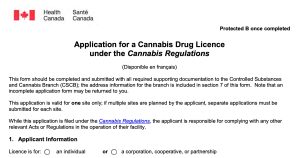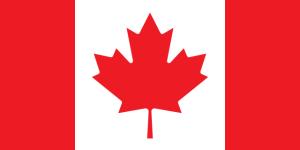12.2 Cannabis Industry Growth & Regulations
On April 1, 2014 the MMPR (2013) came into force, providing the framework for the start of the commercial cannabis industry in Canada (Canada, December 15, 2012). Under the MMPR, companies interested in becoming licensed medical cannabis producers (LPs) were required to submit applications to Health Canada for review and assessment. Health Canada’s forecasted predictions for profitability in the industry sector (over a billion dollars in sales by 2024), led to a green rush, with large numbers of entrepreneurs vying for a share of the market (Anexco Resources Ltd., May 21, 2014; Tranchemontagne, n.d.).
Despite the volume of interest expressed in obtaining commercial licences, and the outlay of money required for the application process (i.e., hundreds of thousands of dollars or more) (dicentra, September 2, 2014), the rigorous, lengthy, and expensive nature of Health Canada’s LP application process (Jones, June 4, 2014) resulted in a high volume of unsuccessful and incomplete applications, and ultimately only a small number of LPs. For example, by June 2014 only 13 LPs were listed on the Health Canada website (Alves & Lickver, June 3, 2014). By the end of 2014, of the 1,300 LP applications received by Health Canada, only 19 full licences had been granted, with 6 additional cultivation-only licences (Visual Capitalist, Spring 2015). According to Laleh Bighash (AAPS, January 16, 2015, para. 6), of the applications to Health Canada between the implementation of the MMPR through to March 2015, “252 were refused, 224 [were] in process, 40 [were] withdrawn, 935 [were] rejected, [and] 643 [were] deemed incomplete.”
Click the link below to learn more about the challenges faced by LPs, and in particular an unsuccessful application for a Windsor-area company:
CEN Biotech to fight medical marijuana licence rejection in court
The federal cannabis licence application process evolved with the introduction of the Access to Cannabis for Medical Purposes Regulations (ACMPR) and subsequently the Cannabis Act (2018). Under the ACMPR, Health Canada announced in May 2017 its plan to streamline the application process in order to both increase the number of LPs and volume of cannabis production (Health Canada, May 26, 2017). As a result of this Heath Canada decision, the number of LPs grew from 44 to 89 between May 2017 and February 2018. With the introduction of the Cannabis Act (2018) and the legalization of the recreational use of cannabis in Canada, federal cannabis regulations expanded to include licence categories specific to: processing cannabis; selling cannabis; selling cannabis for medical purposes; testing cannabis (analytical testing licence); researching cannabis; producing drugs containing cannabis; selling, distributing or receiving drugs containing cannabis; and growing industrial hemp (Health Canada, January 9, 2023). Each type of licence has its own unique application and application process, such as the application for Cultivation and Sale for Medical Purposes Licence. As of August 2023 the number of federal cannabis licences was 957 (Health Canada, August 30, 2023).

Click the following link to learn more about the distribution of retails stores across Canada:
Canadian recreational cannabis stores, by province and territory
In conjunction with the Cannabis Act, the provinces and territories have their own cannabis legislation responsible for governing the retail market within their borders. For example, in Ontario under the provincial Cannabis Licence Act (2018), the Alcohol and Gaming Commission of Ontario (AGCO) is responsible for reviewing retail licence applications and the licensing of retail stores, operators and managers (AGCO, n.d.a; n.d.c). It is also responsible for regulating, monitoring, inspection and enforcement of licensed retail sites (AGCO, n.d.c). The licensing of retail stores in Ontario began slowly via a lottery system, with only 25 Retail Store Authorizations (RSAs) available to applicants as of January 2019. An additional 42 RSAs were included in a second lottery in August 2019, and an open application system was implemented in January 2020 (Maurer, n.d). Although only 18 stores opened in Ontario within the first 6 months of cannabis legalization (compared to 86 in Alberta and 25 in Newfoundland and Labrador) (Myran, Brown & Tanusepurtro, 2019), that number has increase exponentially to 1742 in August 2023, accounting for 46% of all cannabis retail outlets in Canada (MJBizDaily, August 2023). Click here to view the AGCO map of cannabis retail stores in Ontario.
Click the link below to learn more about the AGCO detailed application process:
Cannabis retailer licensing journey map
 Cannabis Industry Regulations Division of Responsibilities
Cannabis Industry Regulations Division of Responsibilities
Oversight of the legal cannabis regulations in Canada are the shared responsibility of the federal, provincial and territorial governments (Canada, July 7, 2021).
“The Federal government’s responsibilities are to set:
- Strict requirements for producers who grow and manufacture cannabis.
- Industry-wide rules and standards, including:
- Types of cannabis products available for sale.
- Packaging and labelling requirements for products.
- Standardized serving sizes and potency.
- Prohibitions on the use of certain ingredients.
- Good production practices.
- Tracking requirements of cannabis from seed to sale to keep it out of the illegal market.
- Restrictions on promotional activities.
Provinces and territories are responsible for developing, implementing, maintaining and enforcing systems to oversee the distribution and sale of cannabis. They are also able to add their own safety measures, such as:
- Increasing the minimum age in their province or territory (but not lowering it).
- Lowering the personal possession limit in their jurisdiction.
- Creating additional rules for growing cannabis at home, such as lowering the number of plants per residence.
- Restricting where adults can consume cannabis, such as in public or in vehicles.”
“The green rush refers to a period of widespread excitement and optimism in the cannabis industry, from investors to companies looking to cash in on what appeared to be a limitless opportunity” (WeedWeek, November 17, 2020, para. 3).

